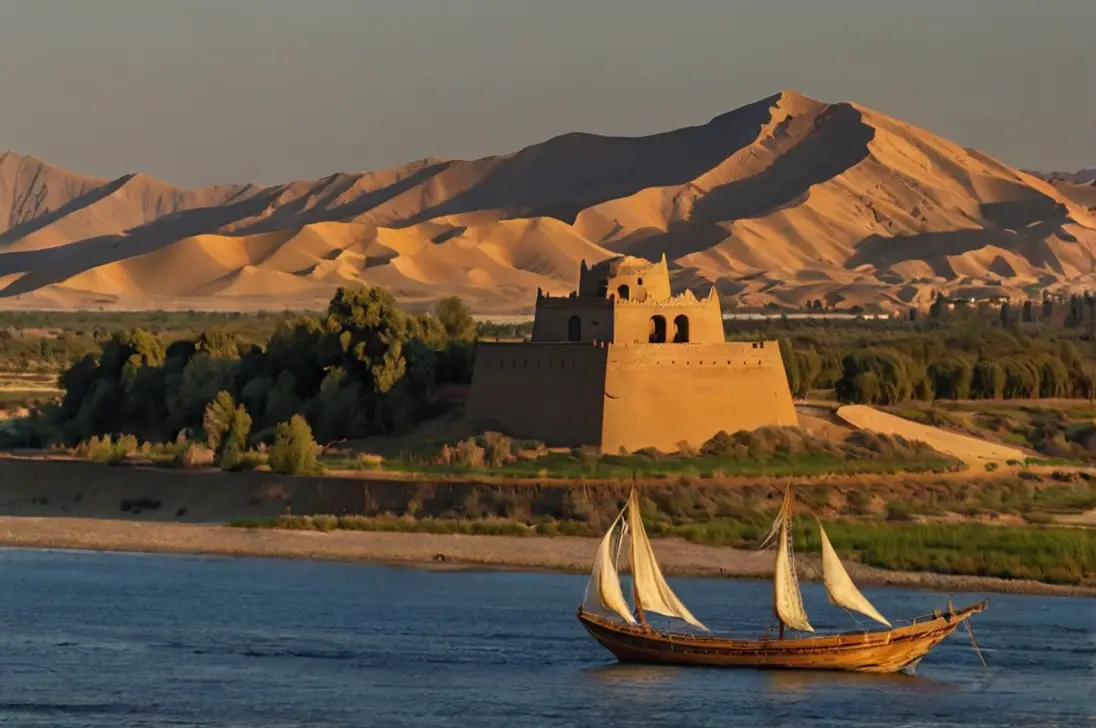
The Silk Road was an extensive network of ancient trade routes that profoundly shaped our world.
It connected distant lands across continents and over many centuries, enabling the exchange not just of goods, but also of ideas, cultures, and innovations.
In this blog post, we will explore what the Silk Road entailed, its impact on trade and business, how it spread ideas and cultures, its influence on global economies, and its enduring legacy in today’s world.
What Was the Silk Road?
The Silk Road was a vast network of trade routes connecting East and West, established during China’s Han Dynasty around 130 BCE.
Stretching over 4,000 miles from China through Central Asia to the Mediterranean, it facilitated trade in goods such as silk, spices, precious metals, textiles, and art.
Beyond commerce, the Silk Road was a pathway for cultural exchange, spreading ideas, religions, and technologies across different civilizations.
It played a crucial role in shaping ancient global interactions and continues to symbolize the historical impact of trade and cultural exchange on our interconnected world.
- Read also: 10 Fascinating Ancient History Facts
- Read also: A Glimpse into Ancient Roman Artifacts

The Silk Road’s Impact on Trade and Commerce
The Silk Road had a significant influence on trade and commerce, bringing about profound changes in economies and societies across regions:
Diversification of goods
The Silk Road introduced a wide variety of products to different parts of the world.
Items like Chinese silk, Indian spices, Persian carpets, and Roman glassware were traded along these routes.
This exchange of goods not only enriched people’s lives by offering new and valuable items but also stimulated economic growth in many places.
Communities had access to goods that were previously unknown to them, creating opportunities for trade and prosperity.
Economic interdependence
Trade along the Silk Road created strong economic ties between distant regions.
Cities such as Samarkand, Baghdad, and Constantinople flourished as bustling trade centers where merchants from different cultures converged.
This interconnectedness not only boosted economic development but also promoted cultural exchange and cooperation among civilizations.
It fostered a global network where goods, ideas, and technologies could flow freely, benefiting societies and economies alike.
Advancement of trade practices
The Silk Road spurred advancements in how trade was conducted.
Merchants developed sophisticated methods for accounting, drafting contracts, and handling currency exchange over long distances.
The use of camel caravans as reliable transportation and the establishment of caravanserais (roadside inns) provided essential infrastructure for trade routes.
These improvements made commerce more efficient and facilitated interactions between traders from diverse backgrounds.

The Silk Road’s Role in Spreading Ideas and Cultures
The Silk Road was more than just a trade route; it served as a vital pathway for the exchange of ideas and cultures across vast distances.
Here’s how it impacted the spread of knowledge and cultural practices:
Spread of religion
The Silk Road played a crucial role in spreading major religions.
Buddhism journeyed from its origins in India to China, Japan, and Korea through these trade routes. I
slam also spread across Central Asia into China, while Christianity and Zoroastrianism found new followers in regions connected by the Silk Road.
This movement of religions contributed to cultural diversity and influenced belief systems along the route.
Cultural exchange
Cultural practices, art, music, and literature thrived along the Silk Road.
The interaction between Greek, Persian, Indian, and Chinese artistic styles resulted in a rich blend of cultures.
Artifacts from regions along the Silk Road reflect this cultural amalgamation, showcasing unique artistic expressions that emerged from cross-cultural interactions.
This cultural exchange enriched civilizations and promoted mutual understanding among diverse peoples.
Intellectual exchange
The Silk Road facilitated the exchange of scientific and technological knowledge that had a profound impact on global progress.
Innovations like papermaking, gunpowder, and the compass spread from China to the West through these trade routes, driving advancements in technology and commerce.
Conversely, mathematical and astronomical knowledge from the Islamic world traveled eastward, contributing to scientific developments in East Asia.
This intellectual exchange accelerated innovation and broadened the horizons of societies along the Silk Road.

The Silk Road’s Influence on Global Economies
The Silk Road had a profound impact on economies worldwide, transforming trade and finance in several significant ways:
Economic growth
The thriving trade along the Silk Road stimulated economic growth in numerous regions.
Cities and towns along the route prospered as bustling trade centers, benefiting from increased business and cultural exchange.
The demand for goods like silk, spices, and precious metals boosted local economies, fostering the growth of industries and infrastructure.
This economic prosperity contributed to the wealth and influence of cities such as Samarkand, Baghdad, and Constantinople.
Emergence of financial systems
The complexity of Silk Road trade necessitated the development of early financial systems.
Merchants devised instruments like letters of credit and bills of exchange to facilitate secure transactions over long distances.
These innovations laid the groundwork for modern banking practices, providing safer and more efficient means of conducting business across diverse cultures and languages.
The evolution of financial systems along the Silk Road enabled smoother trade operations and fostered trust among traders.
Integration of markets
The Silk Road interconnected distant markets, creating a proto-globalized economy.
Goods from China, India, Persia, and the Mediterranean circulated along these trade routes, influencing prices and supply across vast regions.
The integration of markets led to fluctuations in prices for commodities such as silk and spices, similar to the dynamics observed in today’s global marketplaces.
This interconnectedness facilitated the exchange of goods and ideas, laying the groundwork for broader economic interactions and cultural diffusion.

The Silk Road’s Legacy in Modern Times
The impact of the Silk Road continues to resonate across various aspects of contemporary life:
Cultural heritage
The Silk Road facilitated a rich exchange of cultures, leaving a lasting legacy that influences modern societies.
Culinary traditions, languages, arts, and architectural styles reflect the diverse interactions along these ancient trade routes.
Cities such as Xi’an in China and Istanbul in Turkey still bear the cultural marks of their historical roles as pivotal Silk Road hubs.
This cultural fusion enriches our understanding of global heritage and promotes cultural diversity today.
Modern trade routes
The idea of interconnected trade routes pioneered by the Silk Road has inspired modern initiatives like China’s Belt and Road Initiative (BRI).
This ambitious project seeks to revive and expand the ancient trade routes, fostering economic cooperation and connectivity across Asia, Europe, and Africa.
By enhancing infrastructure and promoting trade relations, the BRI aims to stimulate global economic growth and facilitate international trade in the 21st century.
Tourism and education
The historical significance of the Silk Road attracts tourists and scholars alike.
UNESCO’s Silk Road Programme plays a crucial role in preserving and promoting the cultural heritage of these ancient routes.
By safeguarding archaeological sites, monuments, and artifacts, the programme seeks to ensure that future generations can appreciate the Silk Road’s impact on global history.
This cultural preservation also fosters educational opportunities, deepening our knowledge of ancient civilizations and their contributions to human development.
- Read also: Slavery in Ancient Greece: An In-depth Exploration
- Read also: Navigating the Sands of Time: An Ancient Chinese Civilization Timeline
Conclusion
The Silk Road was more than a series of trade routes; it was a bridge between civilizations.
Its impact on trade, culture, and economies has shaped the world in profound ways.
By fostering economic interdependence, cultural exchange, and intellectual advancement, the Silk Road created a legacy that continues to influence our global society.
FAQs
The primary purpose of the Silk Road was to facilitate trade between the East and West, particularly the exchange of luxury goods like silk, spices, and precious metals.
The Silk Road significantly impacted global trade by diversifying the goods available in different regions, fostering economic interdependence, and advancing trade practices.
The Silk Road facilitated the spread of major religions, cultural practices, artistic styles, and intellectual knowledge between diverse civilizations.
China’s Belt and Road Initiative (BRI) is a modern effort to revive and expand the ancient trade routes, promoting economic cooperation and connectivity between Asia, Europe, and Africa.
The Silk Road’s legacy of cultural exchange, economic interdependence, and innovation continues to influence modern global trade, tourism, and education, making it a significant historical phenomenon.



